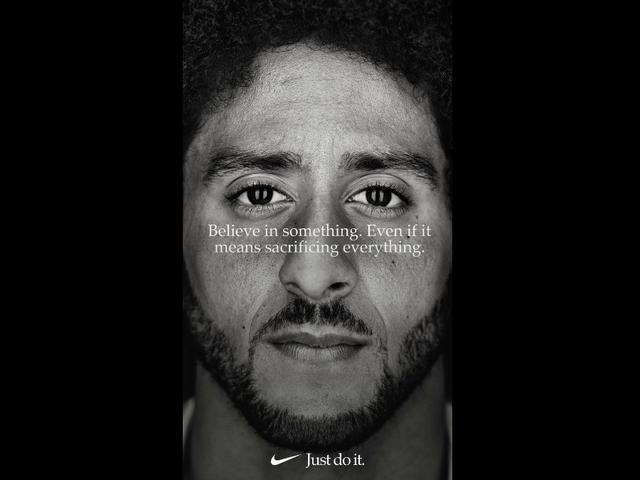
Find a values match between your cause and your constituents’ beliefs
If you haven’t cottoned onto the fact that all marketing – nonprofit included – has vastly changed since the digital revolution, perhaps this incident will wake you up.
And I’m hoping it will persuade you to stop thinking so much about “engagement best practices” – all the social media tools and online strategies you read about every time you turn around, and where you’re directly competing with every business on the planet, instagramming friends, and whatnot – and begin to focus on an area where nonprofits have an unfair advantage.
Deliver meaning.
That’s what folks don’t have enough of.
That’s what folks crave.
And that’s what explains Nike’s recent daring move to put forward a polarizing marketing campaign featuring the face of American football quarterback Colin Kaepernick, most famously known for taking a knee during the singing of The Star-Spangled Banner.
In Why did Nike do what they did? Mark Schaefer of Grow, and author of several digital marketing books, lays out why this was such a brilliant idea. Despite the fact it generated controversy, including protesters burning their shoes in the streets. In fact, Schaefer notes what they did is aligned with research he’s been studying for a new book, Marketing Rebellion, which will come out in 2019. It will be all about how to connect with customers and build a brand in a world without loyalty.
It has a huge message to deliver to folks in the social benefit sector as well.
You Already Know Most Donors Aren’t Loyal
For at least a decade the Fundraising Effectiveness Project has tracked the dismal donor retention in the nonprofit sector. More folks don’t renew than do. And though there’s been tons of research and wisdom published on how to ameliorate this situation, it’s just not working.
Why?
There are all sorts of reasons, of course. You can read about a ton of them, mostly having to do with poor communication and donor service, here (Adrian Sargeant) and here (Roger Craver). But I think Schaefer has hit on a big reason most folks in the social benefit sector are not talking about enough. And it’s directly related to the new way people access information.
People are two-thirds down the track towards forming an impression of you before you even know they exist.
Before the digital revolution, an information imbalance existed. This facilitated a one-way ‘push’ model of marketing/fundraising. Guess what? That imbalance is gone. Everyone has access to information now and chances are good that folks are already two-thirds down the path towards engagement with you before you even know they exist! So you’ve got to think not only about them helping you but about you helping them.
Where you used to be able to determine your brand, and then broadcast it outwards, that’s no longer the case. Outbound marketing has gone the way of the dinosaur.
Stop defining yourself by what you’re not (nonprofit) and begin defining yourself by what you are (social benefit). Move beyond outbound telling marketing to inbound sharing marketing. You must source the wisdom of the crowd, and shift your focus from outcomes to value. Merely “transacting” no longer cuts it.
You Don’t Control Your Marketing
Recent research by McKinsey showed two-thirds of marketing is not your marketing; it’s taking place someplace else.
“The proliferation of decision influencers—along with the growing amount of data about them and their behavior—reverses the funnel logic. It’s now possible to follow the lead of customers rather than force them to follow the sales organization.”
— McKinsey
This is supported by research in Harvard Business Review. Consumers are in control. If you believe donors want to have a relationship with your cause, this research shows you’re flat out mistaken:
“77% of customers do not want to have a relationship with our brand. In fact, 87% of customers shop around, there’s almost no brand loyalty today.”
— Harvard Business Review
Folks are brand agnostic.
They’re focused on value. And on feeling sure they can trust you.
What can you deliver that people are looking for?
If you don’t think from your consumer’s perspective, and answer the WIIFM (What’s In It For Me) question, you’re simply not going to attract much interest.
You Can’t Inspire Philanthropy Solely Through Engagement
The other myth Schaefer busts is that customer engagement builds relationships. Nope. Folks could engage with you numerous times, and still not quite find a reason to trust you. Or a reason to make a philanthropic investment ‘purchase.’ In fact, they may find quite the opposite.
So simply blasting out a lot of social media posting and online content will not ipso facto build the types of relationships that will sustain your organization.
There is no correlation between customer loyalty and brand interaction.
Uh, oh.
However, there’s some really terrific news for nonprofits in this research: One factor is associated with brand loyaltyl
Shared meaning.
Woo hoo!
Nonprofits possess meaning in spades. In fact, all of fundraising simply boils down to a value-for-value exchange. If you can give back to donors something they value, in exchange for the value they deliver to you, you’re in like flint.
Shared meaning is what rocks loyalty in today’s zeitgeist.
Press Your Unfair Advantage
Schaefer shares research from Edelman showing more than half of customers seek out brands that align with their values. In fact, they won’t buy absent a feeling the company from which they’re buying aligns with their beliefs. It’s what drives cause marketing, of course. For-profit businesses have a hard time looking like “good guys.”
Nonprofits ooze values
Values that can potentially align with whoever is encountering you online.
But… you have to make the case and put those values out there. Big time.
Sadly, too many nonprofits hide their light under a bushel.
If your values proposition is hard to find, folks will move on.
Proudly Take a Stand
Don’t just be an arts organization that puts on plays.
Be an arts organization with a mission that’s larger than what you do. A vision that speaks to the values you enact. A brand that draws folks in because your values align with theirs.
EXAMPLE: San Francisco Playhouse:
Mission: “To share stories that uplift our spirits, deepen self-awareness and nurture a compassionate community.”
Vision: The Empathy Gym
“Our theater is an empathy gym where we come to practice our powers of compassion. Here, safe in the dark, we can risk sharing in the lives of the characters. We feel what they feel, fear what they fear, and love what they love. And as we walk through our doors we take with us greater powers of understanding to make our community a better place, one play at a time.”
Mark Schaefer writes: “Consumers want brands to take a stand, they need them to take a stand. It is the only thing that results in brand loyalty.”
Of course, it’s not simply about taking a stand. It’s about taking the right stand.
One that truly reflects your existential reason for being.
Look into Your Organizational Soul
That’s what Nike did.
They knew the risk. They weren’t oblivious to the fact they might take a short-term hit. (They did, with their stock suffering its biggest single day drop in several months). But they also knew over the long term this strategy would likely pay off by attracting the next generation of young and racially diverse consumers they want as customers. And even in the short term they gambled they would receive a lot of positive publicity.
They knew their brand, inside and out. They knew the meaning the preponderence of their customers were seeking.
Their marketing strategy aligned beautifully with what they’re known for: Just Do It.
And then they added the beautiful line that connects with the meaning all people seek: “Believe in something.”
Of course, even if you know your heart and soul it doesn’t mean everyone will like you.
Nike will lose some customers.
You’ll lose some customers too if you take a stand.
But… you’ll be someone distinguishable from the crowd.
Someone folks can relate to. A brand with whom people can identify. A mission they want to join, because it aligns with their values.
Humans are on a Meaning Quest
Your job is to facilitate your donor’s philanthropic journey. Their journey to discover their purpose.
You may recall the highest level people can reach on Maslow’s pyramid is self-actualization. Maslow posited that once basic security needs are met (food, shelter, safety) we begin to look for other ways to satisfy our existence. We need a raison d’etre beyond mere survival. We seek family, community and belonging. We seek a greater purpose. We seek to identify with the highest version of ourselves. We want to love the person we look at in the mirror.
Help donors channel their values in a positive, expressive direction.
People give when they feel doing so is a genuine expression of who they are.
The believing, and then expressing that belief through doing and giving, is what makes them feel good.
Not engagement, per se.
Meaning.
Never lose sight of the change you’re endeavoring to bring about. That’s the promise folks want to invest in.
Positive, transformative change.






It’s “In Like Flynn”…not flint.
Otherwise…great article
I was debating which was correct, but was too lazy to look it up. The Urban Dictionary agrees! “Used by morons who are either too stupid, young, or lazy to make themselves aware of the original meaning of the phrase “In like FLYNN.” Originated from the actor ERROL FLYNN, who was an early twentieth century actor well known for being a ladies man.Next time you hear someone say ‘in like flint’ slap them unless they’re talking about the 1967 movie by the same title.” Of course, there was also a 1967 movie I used to watch with my Dad, In Like Flint, wherein secret agent James Coburn wages war on a female secret society that is plotting world domination. 🙂
I could not agree more, Claire. This is brilliant, and so needed right now. Arts organizations can stand for more than just excellence. They can find ways to support the community that supports them.